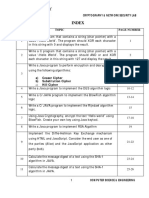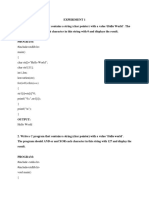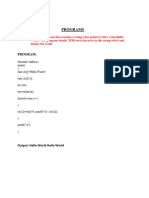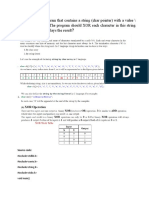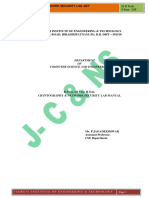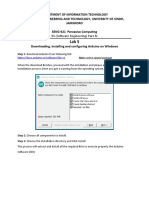SHRI SHANKARPRASAD AGNIHOTRI COLLEGE OF
ENGINEERING, WARDHA
Department of Computer Science and Engineering
LABORATORY MANUAL
Session:- 2024-25
(Winter- 2024)
Name of Faculty: Prof. N. B. Vairagade
Subject: Cryptography and Network Security Subject Code:
Semester: VII SEMESTER Section: CSE
Index
Sr. Name of Practical Page No.
No.
1 Write a C program that contains a string(char pointer) with a value \Hello World. The programs
should XOR each character in this string with 0 and display the result.
2 Write a C program that contains a string (char pointer) with a value \Hello World. The program
should AND or and XOR each character in this string with 127 and display the result.
3 Write a Java program to perform encryption and decryption using the following algorithms:
a. Ceaser Cipher
b. Substitution Cipher
c. Hill Cipher
4 Write a Java program to implement the DES algorithm logic
5 Write a C/JAVA program to implement the Blowfish algorithm logic
6 Write a Java program to implement RSA Algorithm
7 Implement the Diffie-Hellman Key Exchange mechanism using HTML and JavaScript.
8 Calculate the message digest of a text using the SHA-1 algorithm in JAVA.
9 Write the RC4 logic in Java Using Java Cryptography, encrypt the text “Hello world” using
Blowfish. Create your own key using Java key tool.
10 Calculate the message digest of a text using the MD5 algorithm in JAVA.
1
� PRACTICAL NO: 1
AIM: Write a C program that contains a string(char pointer) with a value\Hello World’. The program
Should XOR each character in this string with 0 an display the result.
PROGRAM :
#include<stdio.h>
main()
{
char str[]="Hello World";
char str1[11];
int i,len;
len=strlen(str);
for(i=0;i<len;i++)
{
str1[i]=str[i]^0; printf("%c",str1[i]);
}
printf("\n");
}
OUTPUT: Hello World Hello World
RESULT:Thus we have successfully executed Hello World program
Should XOR each character in this string with 0 an display the result.
2
� PRACTICAL NO: 2
AIM: Write a C program that contains a string (char pointer) with a value \Hello
World’. The program should AND or and XOR each character in this string with 127
and display the result.
PROGRAM:
#include <stdio.h> #include<stdlib.h> void main()
{
char str[]="Hello World"; char str1[11];
char str2[11]=str[]; int i,len; len = strlen(str);
for(i=0;i<len;i++)
{
str1[i] = str[i]&127; printf("%c",str1[i]);
}
printf("\n");
for(i=0;i<len;i++)
{
str3[i]=str2[i]^127; printf("%c",str3[i]);
}
printf("\n");
}
OUTPUT : Hello World
Hello World
Hello World
RESULT: Thus we have successfully executed AND or and XOR each character in this string
with 127
3
� PRACTICAL NO: 3
AIM: Write a Java program to perform encryption and decryption using the
following algorithms:
a) Ceaser Cipher
b) Substitution Cipher
c) Hill Cipher
PROGRAM:
a) Ceaser Cipher
import java.io.BufferedReader; import java.io.IOException; import
java.io.InputStreamReader; import java.util.Scanner;
public class CeaserCipher {
static Scanner sc=new Scanner(System.in);
staticBufferedReaderbr=newBufferedReader(newInputStreamReader(System.in));pu
blic static void main(String[] args) throws IOException {
// TODO code application logic here
System.out.print("Enter any String: "); String str = br.readLine(); System.out.print("\
nEnter the Key: ");
int key = sc.nextInt();
String encrypted = encrypt(str, key); System.out.println("\nEncrypted String is: "
+encrypted);
Stringdecrypted=decrypt(encrypted, key); System.out.println("\nDecrypted String is:
"+decrypted); System.out.println("\n");
}
public static String encrypt(String str, int key)
{
String encrypted ="";
for(int i = 0; i < str.length(); i++)
{
4
�int c= str.charAt(i);
if (Character.isUpperCase(c))
{
c = c + (key % 26); if (c > 'Z')
c = c - 26;
}
else if (Character.isLowerCase(c)) { c = c + (key % 26);
if (c > 'z')
c = c - 26;
}
encrypted += (char) c;
}
return encrypted;
}
public static String decrypt(String str, int key)
{
String decrypted = "";
for(int i= 0; i< str.length(); i++)
{
int c= str.charAt(i); if(Character.isUpperCase(c))
{
c = c - (key % 26);
if (c < 'A')
c = c + 26;
}
else if (Character.isLowerCase(c))
{
c = c - (key % 26);
if (c < 'a')
5
�}
c = c + 26;
}
Output:
Enterany String: HelloWorld Enter the Key: 5
Encrypted String is: MjqqtBtwqi DecryptedStringis: HelloWor
b) Substitution Cipher
PROGRAM:
import java.io.*; import java.util.*;
public class SubstitutionCipher
{
static Scanner sc = new Scanner(System.in);
staticBufferedReaderbr=newBufferedReader(newInputStreamReader(System.in))
;public static void main(String[] args) throws IOException
{
// TODO code application logic here String a
String a= "abcdefghijklmnopqrstuvwxyz"; String b =
"zyxwvutsrqponmlkjihgfedcba"; System.out.print("Enter any string: "); String str =
br.readLine();
String decrypt = ""; char c;
for(int i=0;i<str.length();i++)
{
c=str.charAt(i);
int j = a.indexOf(c);
decrypt = decrypt+b.charAt(j);
}
6
�System.out.println("The encrypted data is: " +decrypt);
}
}
Output:
Enter any string: aceho
The encrypted data is: zxvsl
c) Hill Cipher
PROGRAM:
import java.io.*; import java.util.*;
import java.io.*; public class HillCipher { staticfloat[][] decrypt= newfloat[3][1];
staticfloat[][] a= newfloat[3][3];
static float[][]b=newfloat[3][3]; staticfloat[][] mes=newfloat[3][1]; staticfloat[][]res=
new float[3][1];
static BufferedReader br = new BufferedReader(new
InputStreamReader(System.in)); static Scanner sc = new Scanner(System.in);
public static void main(String[] args) throws IOException {
//TODOcode applicationlogic here getkeymes(); for(int i=0;i<3;i++)
for(int j=0;j<1;j++) (int k=0;k<3;k++) {
res[i][j]=res[i][j]+a[i][k]*mes[k][j];
}
System.out.print("\nEncrypted string is : "); for(int i=0;i<3;i++)
{ System.out.print((char)(res[i][0]%26+97)); [i][0]=res[i][0];
}
inverse();
for(int i=0;i<3;i++) for(int j=0;j<1;j++) for(int k=0;k<3;k++)
7
�{
decrypt[i][j] = decrypt[i][j]+b[i][k]*res[k][j]; } System.out.print("\nDecrypted string
is : ");
8
�for(inti =0;i<3;i++)
{
System.out.print((char)(decrypt[i][0]% 26+97));
}
System.out.print("\n");
}
public static void getkeymes() throws IOException
{
System.out.println("Enter 3x3 matrix for key (It should be inversible): "); for(int
i=0;i<3;i++)
for(int j=0;j<3;j++) a[i][j]= sc.nextFloat();
System.out.print("\nEnter a 3 letter string: "); String msg = br.readLine();
for(int i=0;i<3;i++) mes[i][0]
= msg.charAt(i)-97;
}
public static void inverse()
{
floatp,q; float[][] c= a;
for(int i=0;i<3;i++) for(int j=0;j<3;j++) {
//a[i][j]=sc.nextFloat(); if(i==j)
b[i][j]=1; else b[i][j]=0;
}
for(int k=0;k<3;k++)
{
for(int i=0;i<3;i++)
{
9
�p = c[i][k];
q = c[k][k];
for(int j=0;j<3;j++)
{
if(i!=k)
c[i][j] = c[i][j]*q-p*c[k][j];
b[i][j] =b[i][j]*q-p*b[k][j];
}}}}
for(int i=0;i<3;i++) for(int j=0;j<3;j++)
{ b[i][j] = b[i][j]/c[i][i]; }
System.out.println(""); System.out.println("\nInverse Matrix is : "); for(int i=0;i<3;i+
+) { for(int j=0;j<3;j++) System.out.print(b[i][j] + " ");
System.out.print("\n"); }
}}
Output:
Entera3letterstring: hai Encrypted string is :fdx Inverse Matrix is: 0.083333336
0.41666666 -0.33333334
-0.41666666 -0.083333336 0.6666667
0.5833333 -0.083333336 -0.33333334
Decrypted string is: hai
RESULT: Thus we have successfully executed encryption and decryption
10
� PRACTICAL NO: 4
AIM: Write a Java program to implement the DES algorithm logic.
PROGRAM:
import java.util.*;
import java.io.BufferedReader; import java.io.InputStreamReader; import java.security.spec.KeySpec;
import javax.crypto.Cipher; import javax.crypto.SecretKey;
import javax.crypto.SecretKeyFactory; import javax.crypto.spec.DESedeKeySpec;
import sun.misc.BASE64Decoder; import sun.misc.BASE64Encoder; public class DES{
private static final String UNICODE_FORMAT = "UTF8";
public static final String DESEDE_ENCRYPTION_SCHEME = "DESede";
privateKeySpecmyKeySpec;
privateSecretKeyFactorymySecretKeyFactory;
private Cipher cipher; byte[] keyAsBytes;
private String myEncryptionKey;
private String myEncryptionScheme; key;
static BufferedReader br = new BufferedReader(new InputStreamReader(System.in));
publicDES()throws Exception{
// TODO code application logic here my
11
�myEncryptionKey= "ThisIsSecretEncryptionKey";
myEncryptionScheme = DESEDE_ENCRYPTION_SCHEME;
keyAsBytes=myEncryptionKey.getBytes(UNICODE_FORMAT);
myKeySpec== new DESedeKeySpec(keyAsBytes);
mySecretKeyFactory = SecretKeyFactory.getInstance(myEncryptionScheme); cipher
= Cipher.getInstance(myEncryptionScheme);
key = mySecretKeyFactory.generateSecret(myKeySpec);
}
public String encrypt(String unencryptedString)
{ String encryptedString = null;
try {
cipher.init(Cipher.ENCRYPT_MODE, key);
byte[] plainText = unencryptedString.getBytes(UNICODE_FORMAT); byte[] encryptedText =
cipher.doFinal(plainText);
BASE64Encoder base64encoder = new BASE64Encoder(); encryptedString
= base64encoder.encode(encryptedText); } catch (Exception e)
{ e.printStackTrace(); } returnencryptedString; }
public String decrypt(String encryptedString)
{ String decryptedText=null;
try {
cipher.init(Cipher.DECRYPT_MODE, key);
BASE64Decoder base64decoder = new BASE64Decoder(); byte[] encryptedText =
base64decoder.decodeBuffer(encryptedString); byte[] plainText = cipher.doFinal(encryptedText);
decryptedText= bytes2String(plainText); }
catch (Exception e)
12
�{ e.printStackTrace();} returndecryptedText; }
private static String bytes2String(byte[] bytes)
{ StringBufferstringBuffer =new StringBuffer(); for (int i
= 0; i <bytes.length;
i++) { stringBuffer.append((char) bytes[i]); } returnstringBuffer.toString(); }
public static void main(String args []) throws Exception
{ System.out.print("Enter the string: "); DES myEncryptor= new DES();
String stringToEncrypt = br.readLine();
}
}
OUTPUT:
String encrypted = myEncryptor.encrypt(stringToEncrypt); String decrypted
= myEncryptor.decrypt(encrypted); System.out.println("\nString To Encrypt: " +stringToEncrypt);
System.out.println("\nEncrypted Value : "
+encrypted);
System.out.println("\nDecrypted Value : " +decrypted); System.out.println("");
Enterthestring:WelcomeString To Encrypt: Welcome
Encrypted Value : BPQMwc0wKvg= Decrypted Value: Welcome
RESULT: Thus we have successfully executed DES algorithm
13
� PRACTICAL NO: 5
AIM:Write a C/JAVA program to implement the BlowFish algorithm logic.
PROGRAM:
import java.io.*;
import java.io.FileInputStream; import java.io.FileOutputStream; import java.security.Key; import
javax.crypto.Cipher;
import javax.crypto.CipherOutputStream; import javax.crypto.KeyGenerator; import
sun.misc.BASE64Encoder; public class BlowFish{
public static void main(String[] args) throws Exception {
// TODO code application logic here KeyGeneratorkeyGenerator
=KeyGenerator.getInstance("Blowfish"); keyGenerator.init(128); KeysecretKey =
keyGenerator.generateKey();
Cipher cipherOut = Cipher.getInstance("Blowfish/CFB/NoPadding");
cipherOut.init(Cipher.ENCRYPT_MODE, secretKey); BASE64Encoder encoder = new
BASE64Encoder();
byte iv[] = cipherOut.getIV(); if (iv != null) {
System.out.println("Initialization Vectorofthe Cipher:" + encoder.encode(iv)); } FileInputStream fin=
new FileInputStream("inputFile.txt"); FileOutputStreamfout = new FileOutputStream("outputFile.txt");
CipherOutputStreamcout = new CipherOutputStream(fout, cipherOut); intinput
= 0;
while ((input = fin.read()) != -1)
{ cout.write(input); }
fin.close(); cout.close(); } }
OUTPUT:
Initialization Vectorofthe Cipher: dI1MXzW97oQ= Contents of inputFile.txt: Hello World Contents of
outputFile.txt: ùJÖ˜ NåI“
RESULT: Thus we have successfully executed BlowFish algorithm
14
� PRACTICAL NO: 6
AIM: Write a Java program to implement RSA Algoithm.
PROGRAM:
importjava.io.BufferedReader; import java.io.InputStreamReader; import java.math.*;
import java.util.Random; import java.util.Scanner; public class RSA{
static Scanner sc = new Scanner(System.in); public static void main(String[] args){
// TODO code application logic here System.out.print("Enter a Prime number: ");
BigIntegerp= sc.nextBigInteger();// Here'soneprimenumber.. System.out.print("Enter another prime
number: "); BigInteger q = sc.nextBigInteger(); // ..andanother.
BigInteger n = p.multiply(q);
BigInteger n2 = p.subtract(BigInteger.ONE).multiply(q.subtract(BigInteger.ONE)); BigInteger e
= generateE(n2);
BigInteger d = e.modInverse(n2); // Here's the multiplicative inverse
System.out.println("Encryptionkeysare:"+e+","+ n); System.out.println("Decryption keys are: " + d + ",
" + n);
}
public static BigIntegergenerateE(BigIntegerfiofn)
{
int y, intGCD;
BigInteger e; BigInteger gcd; Random x = new Random(); do {
15
�y = x.nextInt(fiofn.intValue()-1); String z = Integer.toString(y); e= new BigInteger(z);
gcd = fiofn.gcd(e); intGCD = gcd.intValue();
}
while(y <= 2 ||intGCD != 1); return e;
}
}
OUTPUT:
Enter a Prime number: 5
Enteranotherprimenumber:11 Encryption keys are: 33, 55
Decryption keys are: 17, 55
RESULT: Thus we have successfully executed RSA Algoithm.
16
� PRACTICAL NO: 7
AIM:Implement the Diffie-Hellman Key Exchange mechanism using HTML and JavaScript.
PROGRAM:
import java.math.BigInteger; import java.security.KeyFactory; import java.security.KeyPair;
import java.security.KeyPairGenerator; import java.security.SecureRandom;
import javax.crypto.spec.DHParameterSpec; import javax.crypto.spec.DHPublicKeySpec; public class
DiffeHellman{
public final static int pValue = 47;
public final static int gValue = 71; public final static int XaValue = 9; publicfinalstaticint XbValue= 14;
public static void main(String[] args) throws Exception
{ // TODO code application logic here
BigInteger p = new BigInteger(Integer.toString(pValue)); BigInteger g = new
BigInteger(Integer.toString(gValue)); BigIntegerXa = new BigInteger(Integer.toString(XaValue))
; BigIntegerXb = new BigInteger(Integer.toString(XbValue)); createKey(); intbitLength = 512; // 512
bits SecureRandomrnd = new SecureRandom();
p = BigInteger.probablePrime(bitLength, rnd); g = BigInteger.probablePrime(bitLength, rnd);
createSpecificKey(p, g);
}
public static void createKey() throws Exception { KeyPairGeneratorkpg =
KeyPairGenerator.getInstance("DiffieHellman"); kpg.initialize(512);
KeyPairkp = kpg.generateKeyPair();
KeyFactorykfactory = KeyFactory.getInstance("DiffieHellman"); DHPublicKeySpeckspec =
(DHPublicKeySpec)
17
�kfactory.getKeySpec(kp.getPublic().DHPublicKeySpec.class); System.out.println("Public key is: "
+kspec);
}
public static void createSpecificKey(BigInteger p, BigInteger g) throws Exception
{
KeyPairGeneratorkpg = KeyPairGenerator.getInstance("DiffieHellman"); DHParameterSpecparam =
new DHParameterSpec(p, g); kpg.initialize(param);
KeyPairkp = kpg.generateKeyPair();
KeyFactorykfactory = KeyFactory.getInstance("DiffieHellman"); DHPublicKeySpeckspec =
(DHPublicKeySpec) kfactory.getKeySpec(kp.getPublic(), DHPublicKeySpec.class);
System.out.println("\nPublic key is : " +kspec);
}
}
OUTPUT:
Public key is: javax.crypto.spec.DHPublicKeySpec@5afd29 Public key is: javax.crypto.spec.
DHPublicKeySpec@9971a
RESULT: Thus we have successfully executed Diffie-Hellman Key Exchange mechanism using
HTML and JavaScript
18
� PRACTICAL NO: 8
AIM: Calculate the message digest of a text using the SHA-1 algorithm in JAVA
PROGRAM:
import java.security.*; public class SHA1 {
public static void main(String[] a) { try
{
MessageDigest md = MessageDigest.getInstance("SHA1");
System.out.println("Message digest object info: "); System.out.println(" Algorithm = "
+md.getAlgorithm()); System.out.println(" Provider = " +md.getProvider());
System.out.println(" ToString = " +md.toString()); String input = ""; md.update(input.getBytes());
byte[] output = md.digest(); System.out.println();
System.out.println("SHA1(\""+input+"\") = " +bytesToHex(output));
input = "abc"; md.update(input.getBytes()); output = md.digest(); System.out.println();
System.out.println("SHA1(\""+input+"\") = " +bytesToHex(output));
input = "abcdefghijklmnopqrstuvwxyz"; md.update(input.getBytes()); output = md.digest();
System.out.println();
System.out.println("SHA1(\"" +input+"\") = " +bytesToHex(output)); System.out.println
}
catch (Exception e) {
System.out.println("Exception: " +e);
}
}
19
�public static String bytesToHex(byte[] b) {
char hexDigit[] = {'0', '1', '2', '3', '4', '5', '6', '7', '8', '9', 'A', 'B', 'C', 'D', 'E', 'F'};
StringBufferbuf=new StringBuffer(); for (int j=0; j<b.length;j++)
{ buf.append(hexDigit[(b[j] >> 4) & 0x0f]); buf.append(hexDigit[b[j] & 0x0f]);
}
returnbuf.toString(); }
}
OUTPUT:
Message digest object info: Algorithm = SHA1 Provider = SUN version 1.6 ToString = SHA1 Message
Digest from SUN, <initialized> SHA1("") = DA39A3EE5E6B4B0D3255BFEF95601890AFD80709
SHA1("abc") = A9993E364706816ABA3E25717850C26C9CD0D89D
SHA1("abcdefghijklmnop qrstuvwxyz")=32D10C7B8CF96570 CA04CE37F2A19D8424 0D3A89
RESULT: Thus we have successfully executed digest of a text using the SHA-1 algorithm in
20
� PRACTICAL NO: 9
AIM: Write the RC4 logic in Java Using Java Cryptography, encrypt the text “Hello world” using
Blowfish. Create your own key using Java key tool.
PROGRAM:
import javax.crypto.Cipher; import javax.crypto.KeyGenerator; import javax.crypto.SecretKey; import
javax.swing.JOptionPane; public class BlowFishCipher {
public static void main(String[] args) throws Exception {
// create a key generator based upon theBlowfish cipher KeyGeneratorkeygenerator =
KeyGenerator.getInstance("Blowfish");
// create a key // create a cipher based upon Blowfish Cipher cipher = Cipher.getInstance("Blowfish");
// initialise cipher to with secret key cipher.init(Cipher.ENCRYPT_MODE, secretkey);
// get the text to encrypt
String inputText = JOptionPane.showInputDialog("Input your message: ");
byte[] encrypted = cipher.doFinal(inputText.getBytes());
//re-initialisetheciphertobeindecryptmode cipher.init(Cipher.DECRYPT_MODE, secretkey);
// decrypt message
byte[] decrypted = cipher.doFinal(encrypted);
// and display the results
JOptionPane.showMessageDialog(JOptionPane.getRootFrame(), "\nEncrypted text:"+ new
String(encrypted)+"\n"+"\nDecryptedtext:"+ new String(decrypted));
System.exit(0);
}}
OUTPUT:
Input your message: Helloworld Encrypted text: 3ooo&&(*&*4r4 Decrypted text: Hello world
Result: Thus we have successfully executed encrypt the text “Hello world” using Blowfish.
21
� PRACTICAL NO: 10
AIM: Calculate the message digest of a text using the MD5 algorithm in JAVA.
PROGRAM:
import java.math.BigInteger;
import java.security.MessageDigest;
import java.security.NoSuchAlgorithmException;
// Java program to calculate MD5 hash value
public class MD5 {
public static String getMd5(String input)
{
try {
// Static getInstance method is called with hashing MD5
MessageDigest md = MessageDigest.getInstance("MD5");
// digest() method is called to calculate message digest
// of an input digest() return array of byte
byte[] messageDigest = md.digest(input.getBytes());
// Convert byte array into signum representation
BigInteger no = new BigInteger(1, messageDigest);
// Convert message digest into hex value
String hashtext = no.toString(16);
while (hashtext.length() < 32) {
hashtext = "0" + hashtext;
}
22
�return hashtext;
}
// For specifying wrong message digest algorithms
catch (NoSuchAlgorithmException e) {
throw new RuntimeException(e);
}
}
// Driver code
public static void main(String args[]) throws NoSuchAlgorithmException
{
String s = "GeeksForGeeks";
System.out.println("Your HashCode Generated by MD5 is: " + getMd5(s));
}
OUTPUT:
Input : hello world
Output : 5eb63bbbe01eeed093cb22bb8f5acdc3
Input : GeeksForGeeks
Output : e39b9c178b2c9be4e99b141d956c6ff6
RESULT: Thus we have successfully executed digest of a text using the MD5 algorithm
23

















